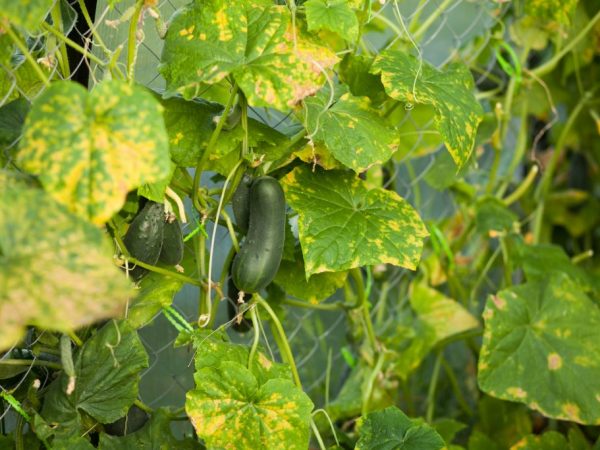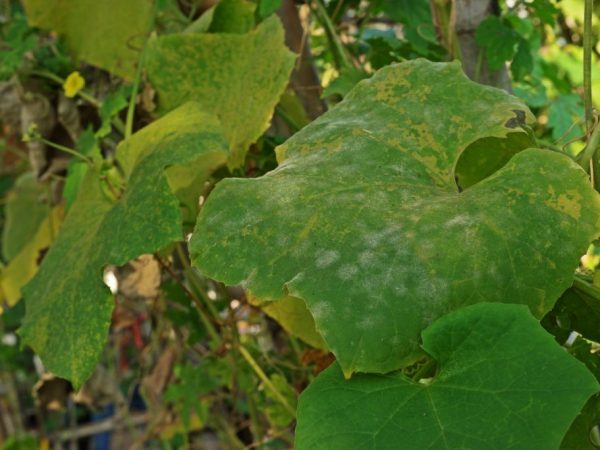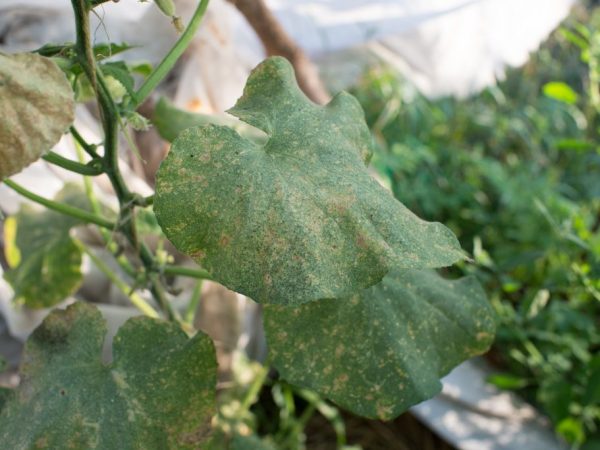Treatment of cucumber diseases in the greenhouse
In the warmth of the film shelter, not only vegetable crops, but also harmful microorganisms grow and develop well. Diseases of cucumbers in a greenhouse develop quite rapidly, and in an enclosed space, the pathogen quickly spreads to healthy plants.

Treatment of cucumber diseases in the greenhouse
It is best to carry out preventive treatment of the beds. But if the plants are already sick, then you will have to resort to the help of specialized drugs. They help in growing and allow you to more effectively fight pests and pathogens.
What are the diseases of cucumbers in the greenhouse
In order to win in the fight against diseases of cucumbers in the greenhouse, you need to know as much as possible about their pathogens. An experienced gardener can at first glance determine what exactly the plants are sick with and quickly pick up what to treat them with. Beginners, on the other hand, may not be able to cope with this task without help. Since most diseases are caused by a fungus, their symptoms are very similar.
Rot
The main enemy of greenhouse cucumbers is rot. It affects not only fruits and leaves, but also roots. The causative agents of this disease are molds. There are many reasons for the development of rot. First of all, the plant is affected by ventilation disturbances in the greenhouse, as well as excessive air humidity.
Fungal spores do not come from anywhere, they are brought into the soil along with seeds, diseased seedlings, humus, etc. No one is immune from this, but you can take a number of measures aimed at disinfecting the soil. The best option is sowing mustard seed as green manure, as well as disinfecting the soil using specialized preparations.
There are several types of rot:
- White rot - the leaves and stems of the plant are covered with a white coating and soften over time. Fruits, when rotting, give off a terrible smell and become like frozen ones.
- Gray rot - light gray spots on leaves and fruits. The foci of the disease resemble velvet in their texture. This is nothing more than a "bloom" of the fungus. His disputes so extend to healthy specimens.
- Root rot - brown plaque in the root zone of the stem. The leaves begin to turn yellow and dry quickly. The site of the lesion becomes very thin, and then rotts away. The stem can be severely cracked from disease.
- Black stem rot or ascochitosis - looks like round spots of brown, and later black. They spread along the inner surface of the leaves, and sometimes affect the stems. The plant quickly withers and dies from this disease.
If the distance between the bushes is too small, then the air will not circulate well and fungal rot may develop. It is for this reason that it is not recommended to thicken the planting.
Fungal diseases
In addition to rot, fungal mold spores can cause quite serious diseases. They are able not only to reduce the yield of cucumbers, but also to destroy all plantings.
There are several types of greenhouse cucumber diseases:
- Mealy dew - leaves and fruits are covered with dense gray-white plaques. Over time, the affected areas dry out and fall off. Such a disease causes enormous damage to the economy, leading to the death of the entire crop. Fruits affected by powdery mildew can be eaten after having been peeled, but they are not suitable for conservation.
- Pecronosporosis or downy mildew - manifests itself as faded yellow spots that constantly grow in size. The affected leaves will be burnt, and after that the pathogen affects the shoots themselves.
- Anthracnose - differs in the presence of holes on the leaves. The disease affects the plant with foci, and in this place a bulge first forms, and then a slit-like hole. On the fruits themselves, depressed flaccid areas appear.
The danger of fungal diseases lies in the fact that their spores do not go anywhere, but remain in the ground for many years. In the future, they affect the plant that will be planted in the greenhouse. For the same reason, it is not recommended to plant cucumbers in the same garden for several years in a row.
Bacteriosis

A diseased cucumber should be removed by the root and burned
It is also worth mentioning another dangerous disease. Bacteriosis is also called angular spotting, it is caused by specific marks that are formed by young shoots. Small triangular black dots cover the entire surface of the cucumber.
One of the main consequences of bacteriosis is greenhouse necrosis. A black, dried area forms in the heart of the fruit. So you can lose from 50 to 80% of the crop.
The disease quickly spreads to healthy specimens. In order for the pathogen not to have the opportunity to infect them, the diseased cucumber is removed from the garden along with the root. It is recommended to burn after the plant.
Pests
In addition to various diseases, pests can spoil the planting. Most often, the tops are attacked by aphids, from this it withers and turns yellow. Zelents on such a plant either do not tie, or grow crooked and bitter.
Spider mites can also kill cucumbers. These small creatures reproduce quite quickly. By the time a thin white cobweb is visible on the plant, the colony of ticks will reach an enormous size.
Greenhouse Whitefly got its unusual name for a reason. It does well in humid conditions, unlike previous pests. In order for a beautiful white butterfly to turn out of a nondescript caterpillar, the insect needs to eat up to 3 kg of green mass. It sucks out all the juices from the stems and leaves of the plant, after which it dies.
How to treat cucumbers
Diseases of cucumbers in the greenhouse and their treatment require special attention from the gardener. You can't let them go by themselves, otherwise there is a great chance of losing all plantings and crops. In addition, pathogens can infect other crops that grow nearby.
To combat diseases of cucumbers in the greenhouse and their consequences, it is necessary to treat the plants with special preparations. They are sold in any store selling seeds and related products for the garden and vegetable garden.
The fight against rot begins with the removal of the affected areas of the shoot. If we are talking about root rot, then the shoots of cucumbers are bare from the leaves 10-15 cm from the ground. Next, 3 tablespoons of copper oxychloride are diluted in 0.5 liters of water and all the bushes are sprayed with this solution. It is also recommended to sprinkle them with wood ash. With black stem rot, the plants must be treated with a powder of copper and chalk.
Treatment of fungal diseases and bacteriosis is recommended with fungicides. They are of organic and inorganic origin. What kind of drug to treat their beds is chosen only by the gardener himself. The market offers a huge range of drugs. Some of them poison the soil by accumulating in it.Organic fungicides do not pollute the environment.
Folk remedies

For the treatment of plants, you can use infusions
There is also an alternative treatment for greenhouse cucumbers. These secrets came to us from our ancestors who did not have chemicals at their disposal.
Cucumbers from aphids are treated with a solution of serum and laundry soap. To do this, it is enough to foam it. After the procedure, wet leaves can be powdered with a mixture of wood ash and chalk. To scare off the greenhouse whitefly, onion peels are insisted for a day and then sprayed with this infusion of plants.
Powdery mildew is also commonly treated with serum. Add 1 tablespoon of honey to 1 liter of fermented milk product and spray the shoots. You can do the same with any fungal disease. Downy mildew is also treated with this solution.
Processing rules
Strict personal safety rules must be adhered to when working with fungicides. They have a toxic effect when accumulated in the body. Even the vapors that rise when spraying plantings are poisonous. Contact with the skin or mucous membranes can lead to severe allergic reactions.
For this reason, when working with fungicides, you need to:
- wear closed clothing;
- use a respirator and goggles;
- wash hands and face with soap after finishing work;
- wash clothes at high temperature.
The toxicity of the drug should be kept away from direct sunlight, as well as children. Do not process on a hot afternoon or rainy day.
Prevention
In order not to waste time treating cucumbers, summer residents choose varieties that are resistant to diseases. This does not give a 100% guarantee, but it significantly reduces the likelihood that the culture will not be exposed to diseases.
These varieties are no different from their counterparts, the only difference between them is that they suffer less from diseases.
Prevention plays an important role in the cultivation of cucumbers. In order to grow a good harvest of cucumbers, you need to monitor them. There are a number of rules that are very important:
- humidity in the greenhouse should be no more than 80%;
- the presence of good ventilation and hoods;
- timely removal of diseased shoots;
- soil mulching;
- loosening the soil after watering.
Particular attention should be paid to the choice of planting material. Seeds and seedlings may already be infected. Before planting, the seeds are doused with boiling water in order to disinfect, they are also treated with a weak solution of potassium permanganate.
Conclusion
Treating plants is much more difficult than preventing the disease itself. Therefore, all efforts at the beginning of the growing season of the culture should be put on the prevention of the disease.
In growing cucumbers, you can achieve high results if you adhere to certain rules for planting, watering, caring for and feeding the plant. But even perfect care cannot fail to guarantee the development of the disease, as well as the absence of pests in the greenhouse.


